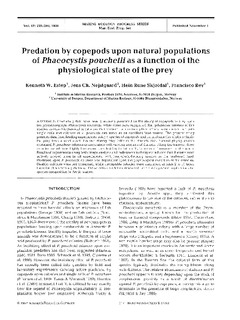| dc.contributor.author | Estep, Kenneth W. | |
| dc.contributor.author | Nejstgaard, Jens Christian | |
| dc.contributor.author | Skjoldal, Hein Rune | |
| dc.contributor.author | Rey, Francisco | |
| dc.date.accessioned | 2007-06-14T12:49:57Z | |
| dc.date.issued | 1990-11-01 | |
| dc.identifier.issn | 0171-8630 | |
| dc.identifier.uri | http://hdl.handle.net/11250/108478 | |
| dc.description.abstract | Conflicting data have been previously presented on the ability of copepods to prey upon
the prymneslophyte Phaeocystis pouchetii. While some have suggested that gelatinous colonies of this species contain biochemical substances that prevent their consumption, others have shown that both single cells and colonies of P. pouchetii can serve as an excellent food source. The present study presents data from feeding experiments using 4 species of copepods and natural samples of phytoplankton prey from a south-north transect during May 1989 in the Barents Sea Natural phytoplankton contained P. pouchetii colonies inn association with varying amounts of diatoms. Along the transect these colonies varied from highly fluorescent and healthy in the north, to weakly fluorescent in the south.
Results of experiments using both image analysis and radiotracer techniques indicate that diatoms were actively preyed upon in all experiments, with long-chain-forming species as the preferred food. Predation upon P. pouchetii colonies as dependent upon the physiological condition of the colonies. Healthy colonies were not consumed, while susceptible colonies were consumed at rates 2 to 10 times those for chain-forming diatoms. The selective predation described here has important implications for
species composition in Arctic waters. | en |
| dc.format.extent | 1233809 bytes | |
| dc.format.mimetype | application/pdf | |
| dc.language.iso | eng | en |
| dc.subject | Phaeocystis pouchetii | en |
| dc.subject | rymneslophyte | en |
| dc.title | Predation by copepods upon natural populations of Phaeocystis pouchetii as a function of the physiological state of the prey | en |
| dc.type | Journal article | en |
| dc.type | Peer reviewed | |
| dc.source.pagenumber | 235-249 | |
| dc.source.volume | 67 | |
| dc.source.journal | Marine Ecology Progress Series | |
| dc.identifier.doi | http://dx.doi.org/10.3354/meps067235 | |
